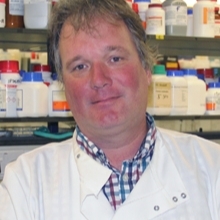Simon Park wins the 2015 Peter Wildy Prize
30 March 2015

Today at the Annual Conference, Dr Simon Park from the University of Surrey will be awarded the 2015 Peter Wildy Prize, recognising his innovative work that brings together art and microbiology. Simon’s work has seen him collaborating with artists to produce paintings using living coloured bacteria and developing a photo booth using bioluminescent microbes. His prize lecture, Exploring The Invisible: adventures in art and microbiology, will be held at 17.35 today.
When were you first aware of science?
I was interested in science and nature from a young age. When I was getting into my teens I remember reading H. G. Wells’ War of the Worlds, which is really a story that’s bookended by micro-organisms: the start of the book is an image of Martians regarding Earth as scientists might look down a microscope, while it ends with Earth’s microbes killing the alien invaders. I realised then that there were really important things that I couldn’t see and from that point on I knew I had to become a microbiologist.
Are you still a Science Fiction fan now?
Oh yes, I read loads of the stuff! I’m a little disappointed that in modern Science Fiction microbes seem to get ignored, whereas they were rather important in H. G. Wells’ day.
You study Campylobacter. What made you focus on bacteria?
At university, of the organisms I studied, I felt viruses a little cold and effectively lifeless, but learning about the astronomical numbers of bacteria that are responsible for the planetary cycling of nutrients and that our mitochondria and chloroplasts have a bacterial origin is what drove me to study this particular microbe. Bacteria normally get very bad press and usually you’d only hear about them when there’s a disease in the news, or when someone is trying to destroy comically animated bacteria in adverts for toilet cleaner! I use my work to put forward their often-overlooked positive aspects.
You’re a very visual scientist and known for your art-science crossovers. How did that avenue of your work come about?
I’ve run a lab class for the past 15 years called Practical and Biomedical Bacteriology, which is a 10-week introductory course for students. For many years, we’ve collected different coloured species of bacteria and got the students to make simple pictures using these microbes. In the back of my mind I always thought that someone with real artistic ability could use this palette of ‘living paint’ to make something wonderful – out of the blue an artist called Jo Wonder contacted me about the very thing! Ultimately, the Wellcome Trust funded our joint application entitled 60 Days of Goodbye Poems of Ophelia, which saw us make a version of John Everett Millais’s painting Ophelia completely out of coloured bacteria.
Why is it important to bring art and science together?
I love the way that art can catch people ‘off guard’ and engage with them in ways that the formal scientific process can’t. Bacteria are far more interesting than just being used as a pigment, so I’ve been investigating other applications they may have. Anne Brodie and I did a project at the Royal Institution, which was a dark tent filled with plates of bioluminescent bacteria. We got people to wander in and out to observe and interact with a phenomenon that many of them had not seen before.
What are you working on at the moment?
In my current project I’m working with an artist called Sarah Craske. The Arts and Humanities Research Council have funded us to look at a copy of Ovid’s Metamorphosis from the 1700s that Sarah found in a book shop. It turns out that it’s quite a valuable manuscript; we’re interested in exploring it as an object because the pages are made out of rags, which would likely have been taken from the clothes of people who died in hospitals. We’re looking to see if there are any viable bacteria from the period – which I doubt – but we’re interested to see if we can find any DNA from the era.
What will you be talking about in your prize lecture?
I’ll be going through the various projects I’ve worked on and discussing the ways it is possible to change and invert the practice of an artist by having them get bacteria to paint themselves. This was a project I had with a watercolour artist called Sarah Roberts. She wanted to find out how bacteria would interact with her paints. We set up an agar plate with a motile red bacterium and various watercolour pigments. When we returned to the lab in the morning, the microbes had moved the paints all over the plate, swirling and rippling the colours. It was very visual but as a scientist it reflected what was happening at the microscopic level; we know that some bacteria coordinate their movement in complex ways to swarm towards compounds they like and I was thrilled to see this represented in the movement of the watercolours.
What does winning this prize mean to you?
As a scientist dabbling in art I’ve always felt slightly uncomfortable, as I’m bridging two disciplines. The award recognises that what I’m doing is making a difference and for that I’m delighted.
Image: Dr Simon Park.
